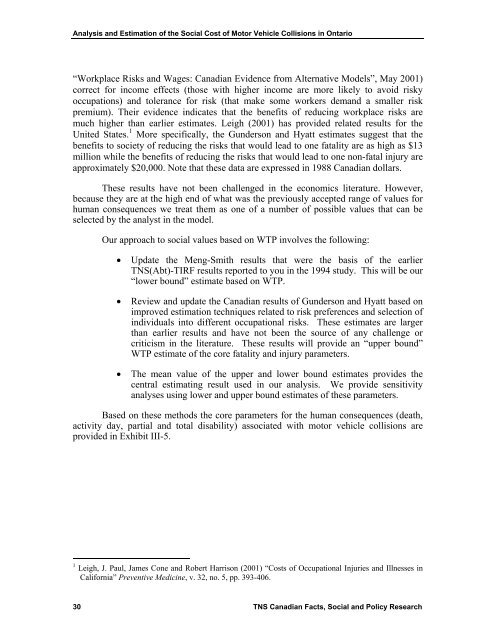Keith Vodden Dr. Douglas Smith - Transports Canada
Keith Vodden Dr. Douglas Smith - Transports Canada
Keith Vodden Dr. Douglas Smith - Transports Canada
Create successful ePaper yourself
Turn your PDF publications into a flip-book with our unique Google optimized e-Paper software.
Analysis and Estimation of the Social Cost of Motor Vehicle Collisions in Ontario<br />
“Workplace Risks and Wages: Canadian Evidence from Alternative Models”, May 2001)<br />
correct for income effects (those with higher income are more likely to avoid risky<br />
occupations) and tolerance for risk (that make some workers demand a smaller risk<br />
premium). Their evidence indicates that the benefits of reducing workplace risks are<br />
much higher than earlier estimates. Leigh (2001) has provided related results for the<br />
United States. 1 More specifically, the Gunderson and Hyatt estimates suggest that the<br />
benefits to society of reducing the risks that would lead to one fatality are as high as $13<br />
million while the benefits of reducing the risks that would lead to one non-fatal injury are<br />
approximately $20,000. Note that these data are expressed in 1988 Canadian dollars.<br />
These results have not been challenged in the economics literature. However,<br />
because they are at the high end of what was the previously accepted range of values for<br />
human consequences we treat them as one of a number of possible values that can be<br />
selected by the analyst in the model.<br />
Our approach to social values based on WTP involves the following:<br />
• Update the Meng-<strong>Smith</strong> results that were the basis of the earlier<br />
TNS(Abt)-TIRF results reported to you in the 1994 study. This will be our<br />
“lower bound” estimate based on WTP.<br />
• Review and update the Canadian results of Gunderson and Hyatt based on<br />
improved estimation techniques related to risk preferences and selection of<br />
individuals into different occupational risks. These estimates are larger<br />
than earlier results and have not been the source of any challenge or<br />
criticism in the literature. These results will provide an “upper bound”<br />
WTP estimate of the core fatality and injury parameters.<br />
• The mean value of the upper and lower bound estimates provides the<br />
central estimating result used in our analysis. We provide sensitivity<br />
analyses using lower and upper bound estimates of these parameters.<br />
Based on these methods the core parameters for the human consequences (death,<br />
activity day, partial and total disability) associated with motor vehicle collisions are<br />
provided in Exhibit III-5.<br />
1 Leigh, J. Paul, James Cone and Robert Harrison (2001) “Costs of Occupational Injuries and Illnesses in<br />
California” Preventive Medicine, v. 32, no. 5, pp. 393-406.<br />
30 TNS Canadian Facts, Social and Policy Research
















